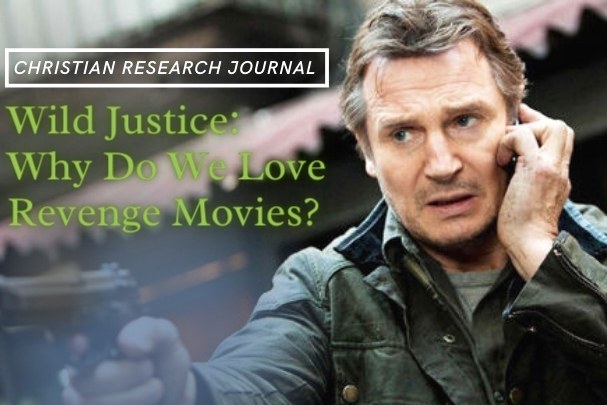I don’t know anyone who would say, in daylight hours, that they want harm to come to their family. But I know more than one person, myself included, who has entertained the dark fantasy of avenging a loved one in a roaring rampage of revenge. Did the hit movie Taken (2008), with its perfectly delivered and iconic dialogue, create this fantasy? Or did it merely tap into an unspoken desire?
As a modern, media-saturated person, I find it hard to tell where my desires originate. Does Liam Neeson’s deep-voiced threat sound cool because we all have a deep-down desire for vigilante justice? Or do I fantasize about vigilante justice because I want to be cool like Liam Neeson when he utters these lines?
I don’t know who you are. I don’t know what you want. If you are looking for ransom I can tell you I don’t have money, but what I do have are a very particular set of skills. Skills I have acquired over a very long career. Skills that make me a nightmare for people like you. If you let my daughter go now that’ll be the end of it. I will not look for you, I will not pursue you, but if you don’t, I will look for you, I will find you and I will kill you.1
Whatever the source, there is no denying that modern action cinema is taken with the premise of Taken. The John Wick2, Taken3, and The Equalizer4 series, among other similar films, have dominated the non-superhero action movie arena. Each feature a lone hero cutting a swath of destruction in their quest for revenge. Revenge, of course, can be just or unjust; proportionate or disproportionate. It is retributive harm.
Rarely do these movies wrestle with questions of ethics. Francis Bacon calls revenge “wild justice.” These films create a scenario where the hero’s quest feels just. The wrongs they revenge are so potent that we desire justice, and we want it to be ‘wild.’ In the three franchises mentioned, the enemies are just wicked, worthy of John Wick’s weapon mastery. These baddies are so powerful that any vengeance will equalize the scales of justice. Bacon writes, “The most tolerable sort of revenge is for those wrongs which there is no law to remedy.”5 To make their quests “tolerable,” popular revenge movies show us that the hero alone, with his special set of skills, can set things right. In the John Wick movies, for instance, there seems to be no law at all. John Wick carries out his rampage in a world that consists of only assassins and witless bystanders.
If there is an ethical question raised by the John Wicks, or the Takens, it is often, “How will this cycle of violence end?” This is a time-tested question, and one which the lex talionis6 sought to answer. Contrary to the quip attributed to Gandhi that “an eye for an eye makes the whole world blind,”7 with its insistence on proportionate punishment, the law of eye-for-eye limits retribution in order to establish basic justice and end violence. An eye for an eye leaves two men with only one eye and then stops. These movies have a different answer, the cycle ends when the hero stands with a smoking gun over his last enemy.
Taken 2 tells the story of the father of the wicked kidnapper that Bryan Mills (Liam Neeson) killed in the first film. Bent on revenge for the death of his kidnapper son, Murad (Rade Serbedzija) goes after Bryan’s family once again, with predictable results. In their final confrontation, Bryan confronts Murad about this very cycle of endless vengeance:
Murad: What are you waiting for?
Bryan: You have other sons?
Murad: Two.
Bryan: And if I kill you, they will come and seek revenge?
Murad: They will for sure.
Bryan: And I will kill them too. You can change that. You can go home, live your life, enjoy your sons, your grandsons.
Murad: And my other son, Marko, the son you killed… am I just supposed to forget it?
Bryan: No, you’ll just have to live with it. Like the parents of all those kidnapped girls. Or you can die here.
Murad: What are you telling me?
Bryan: What I’m saying is, if you give me your word, I will throw down this gun and simply walk away.8
As an olive branch, Bryan hands Murad his gun. True to form, Murad tries to shoot Bryan, only to hear the futile click of an empty pistol. Bryan then kills Murad by crushing his head against a wall. The villain dies but the cycle continues and a sequel is born. Others may come for Bryan but we know that he will “kill them too.”
While Taken trades on more comprehensible moral motivations, John Wick elevates the revenge subgenre to dizzyingly abstract and disproportionate heights. Avenging the murder of his puppy and the theft of his car, John Wick (Keanu Reeves), the world’s-best hitman comes out of retirement to annihilate an entire army of Russian thugs. The peculiar genius of the series is in the abstraction. The movies find the smallest possible pretext that could cinematically justify the greatest possible bodycount. Vengeance plays out in a world whose social axis extends from chaotic criminals on the one side to principled assassins on the other, with no other meaningful society except as backdrop. Effectively directed by former stunt coordinators, the franchise pushes choreographed gunplay and cinematic revenge further than anything else in American cinema.
Repeatedly throughout the John Wick series, the titular hero is referred to as the Boogeyman, Baba Yaga, or the Devil. When asked what he will do every time a new wave of enemies comes against him, he swears, like Bryan in Taken, that he will “kill them” too. And we believe he can. What’s striking about John Wick is that he never feels like the devil. We have sympathy for the devil. We want him to kill all his enemies. Where earlier classics of revenge like Carrie (1976), Cape Fear (1962), and Death Wish (1974) played with the complicated fallout and distortive effects of revenge on the avenger, these more recent entries avoid any moral quandaries. John Wick gives us the fantasy of a devil who gives us the eschatological justice of God. The second and third and fourth coming of John Wick, in a sense, stands as a rough, brutal, and immanent substitute for the second coming of Christ.
Though I am not condemning these films, it is worth thinking about the degree to which our pleasure in seeing the victim carry out vengeance is a departure from a biblical view of justice. The Bible affirms the need for retributive justice through the Mosaic law. The Psalmist cries out for God to punish his unrepentant enemies (Ps. 7). Paul affirms the need for justice, but cedes the role of retribution to the state, encouraging Christians to avoid lawsuits, pray for their enemies, and await divine reckoning. Christians have been marked by their awareness that wrongs must be paid, but also that they have been paid for by the cross. The economy of retribution does not operate within a finite system, but can always draw on a reserve of infinite grace. We long for eschatological justice but not for the sake of seeing our enemies punished. Gilbert Meilaender, in his review of Oliver O’Donovan’s The Ways of Judgment (Eerdmans, 2005), sums it up well:
[W]hereas theories of punishment normally seek to benefit the society at large (by deterrence), the offender (by remediation), and the victim (by retribution), a Christian political ethic leaves no place for the thought that one purpose of punishment is to benefit the victim. God himself has taken the side and the place of victims, and “though government as God’s servant must defend the right of victims” no private act of vengeance is needed or permitted. Hence, “it is a measure of the deep de-Christianization of our times that it is once again possible to speak in public of the victim’s interest in punishment.”9
There are more films I could discuss here. I’ll leave it as homework for someone to analyse the differences between the first Death Wish and its recent remake in 2018. Quentin Tarantino has focused the latter part of his career on revenge, often rewriting history to give us the revisionist pleasure of watching some of history’s most reviled villains (Southern slavers, Adoph Hitler, the Manson family) brutally punished.
A minor theme that I spotted in my viewing for this article is the female-centric revenge film that takes place through social retaliation in movies such as Nine to Five (1980), The First Wives Club (1996), and Mean Girls (2004). A recent film, just now available on-demand, is Promising Young Woman (2020), in which a traumatized med school dropout takes revenge on men who take advantage of women too intoxicated to consent to sex. Pretending to be drunk, the main character allows lecherous creeps to pick her up and waits until they begin to take advantage of her to reveal her sobriety, shaming them for their attempted and intended rape. I won’t spoil the ending of this recent release, but the film portrays a world in which male entitlement is a more deadly and pervasive evil than the gangsters in John Wick. As in those movies, the legal system is so powerless the only available solution is wild justice.
Let me conclude with a highly commendable movie about revenge: In the Bedroom. In his 2001 film, Todd Field shows us the lead-up to, and aftermath of, the murder of an aging couple’s adult son. Faced with the difficult reality of living in the same town as their son’s murderer, the father decides to take revenge. Cleverly killing and hiding the body of the guilty man, the film concludes with the father lying in bed with his wife, wrestling with his revenge. Earlier in the film, his index finger (his trigger finger) was wounded by a rogue lobster. Removing the Band-Aid in the final scene, the father sees the wound has healed. The ambiguity of this final shot leaves the audience to ponder if the healed wound is a symbol of the healing that had come from his revenge, or if it symbolizes the healing that would have come had he had the patience to wait for the pangs of grief to pass. Unlike the action films that have dominated the screen and captured our imagination, In the Bedroom wrestles with the allure of seeking revenge in the short run. It does not chastise those who seek immediate justice, but it suggests, provocatively, that it may be worth waiting for the justice of one who possesses a better “set of skills” to set the world right again.
Philip Tallon is an Assistant Professor of Theology at Houston Baptist University. He is the author of The Poetics of Evil (Oxford University Press, 2011).
NOTES
- Taken, directed by Pierre Morel, written by Luc Besson and Robert Mark Kamen (2008; Los Angeles: Twentieth Century Fox, 2009).
- John Wick (2014); John Wick: Chapter 2 (2017); John Wick: Chapter 3—Parebellum (2019).
- Taken (2008); Taken 2 (2012); Taken 3 (2014).
- The Equalizer (2014).
- Francis Bacon (1625), “Of Revenge,” CommonLit, https://www.commonlit.org/en/texts/on-revenge.
- “Eye for an eye” — law of retaliation or retribution.
- Professor Buzzkill clarifies that the quip stems from the journalist Louis Fischer’s explanation of Gandhi’s thinking, in his biography, Mahatma Gandhi — His Life and Times (London: Jonathan Cape, 1951). “#278 — Gandhi: ‘An Eye for an Eye Makes the Whole World Blind’ — Quote or No Quote?,” https://professorbuzzkill.com/eye-for-eye-gandhi/.
- Taken 2, directed by Oliver Megaton, written by Luc Besson and Robert Mark Kamen (Los Angeles: Twentieth Century Fox, 2012).
- Gilbert Meilaender, “Judging Politics,” First Things, January 2006, https://www.firstthings.com/article/2006/01/judging-politics.









